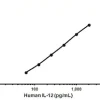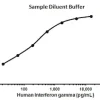- Empty cart.
- Continue Shopping

Human TGF beta 1 ELISA Kit
Human TGF beta 1 ELISA Kit
This product is currently out of stock and unavailable.
Key features and details
- Sensitivity: 80 pg/ml
- Range: 18 pg/ml – 4000 pg/ml
- Sample type: Cell culture supernatant, Plasma, Serum
- Detection method: Colorimetric
- Assay type: Sandwich (quantitative)
- Reacts with: Human
Overview
Product name
Human TGF beta 1 ELISA KitDetection method
ColorimetricPrecision
Intra-assay Sample n Mean SD CV% Overall < 10% Inter-assay Sample n Mean SD CV% Overall < 12% Sample type
Cell culture supernatant, Serum, PlasmaAssay type
Sandwich (quantitative)Sensitivity
< 80 pg/mlRange
18 pg/ml – 4000 pg/mlRecovery
96 %
Sample specific recovery Sample type Average % Range Cell culture supernatant 97.87 85% – 104% Serum 94.46 82% – 102% Plasma 95.78 93% – 103% Assay duration
Multiple steps standard assaySpecies reactivity
Reacts with: HumanProduct overview
Human TGF beta 1 ELISA (Enzyme-Linked Immunosorbent Assay) kit (ab100647) is an in vitro enzyme-linked immunosorbent assay for the quantitative measurement of Human TGF beta 1 in serum, plasma and cell culture supernatants.
This assay employs an antibody specific for Human TGF beta 1 coated on a 96-well plate. Standards and samples are pipetted into the wells and TGF beta 1 present in a sample is bound to the wells by the immobilized antibody. The wells are washed and biotinylated anti-Human TGF beta 1 antibody is added. After washing away unbound biotinylated antibody, HRP-conjugated streptavidin is pipetted to the wells. The wells are again washed, a TMB substrate solution is added to the wells and color develops in proportion to the amount of TGF beta 1 bound. The Stop Solution changes the color from blue to yellow, and the intensity of the color is measured at 450 nm.
Ab100647 was reformulated on 31st May 2018 with new capture and detector antibodies that allows to increase the sensitivity to human TGF beta 1.
Please note that as a consequence of this change, the procedure and protocol have slightly changed and we encourage you to review the protocol steps before starting your experiments
Notes
Optimization may be required with urine samples.
Platform
Microplate
Properties
Storage instructions
Store at -20°C. Please refer to protocols.Components 1 x 96 tests 20X Wash Buffer 1 x 25ml 500X HRP-Streptavidin Concentrate 1 x 200µl 5X Assay Diluent 1 x 15ml Biotinylated anti-Human TGF beta 1 2 vials Recombinant Human TGF beta 1 Standard (lyophilized) 2 vials Stop Solution 1 x 8ml TGF beta 1 Microplate (12 x 8 wells) 1 unit TMB One-Step Substrate Reagent 1 x 12ml Research areas
- Cardiovascular
- Angiogenesis
- Growth Factors
- TGF
- Signal Transduction
- Growth Factors/Hormones
- TGF
- Stem Cells
- Signaling Pathways
- TGF beta
- Secreted
- Cancer
- Growth factors
- TGF
- Cancer
- Invasion/microenvironment
- Angiogenesis
- Angiogenic growth factors
- Cancer
- Cancer Metabolism
- Response to hypoxia
- Kits/ Lysates/ Other
- Kits
- ELISA Kits
- ELISA Kits
- Growth factors and hormones ELISA kits
- Metabolism
- Pathways and Processes
- Cofactors, Vitamins / minerals
- Co-factors
- Metabolism
- Pathways and Processes
- Metabolism processes
- Hypoxia
Function
Multifunctional protein that controls proliferation, differentiation and other functions in many cell types. Many cells synthesize TGFB1 and have specific receptors for it. It positively and negatively regulates many other growth factors. It plays an important role in bone remodeling as it is a potent stimulator of osteoblastic bone formation, causing chemotaxis, proliferation and differentiation in committed osteoblasts.Tissue specificity
Highly expressed in bone. Abundantly expressed in articular cartilage and chondrocytes and is increased in osteoarthritis (OA). Co-localizes with ASPN in chondrocytes within OA lesions of articular cartilage.Involvement in disease
Defects in TGFB1 are the cause of Camurati-Engelmann disease (CE) [MIM:131300]; also known as progressive diaphyseal dysplasia 1 (DPD1). CE is an autosomal dominant disorder characterized by hyperostosis and sclerosis of the diaphyses of long bones. The disease typically presents in early childhood with pain, muscular weakness and waddling gait, and in some cases other features such as exophthalmos, facial paralysis, hearing difficulties and loss of vision.Sequence similarities
Belongs to the TGF-beta family.Post-translational
modificationsGlycosylated.
The precursor is cleaved into mature TGF-beta-1 and LAP, which remains non-covalently linked to mature TGF-beta-1 rendering it inactive.Cellular localization
Secreted > extracellular space > extracellular matrix.






















